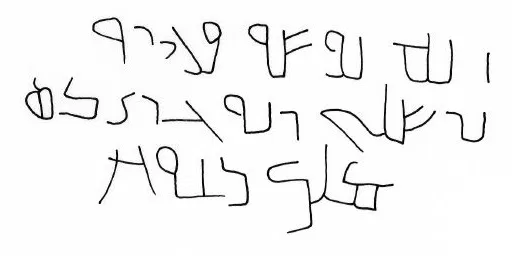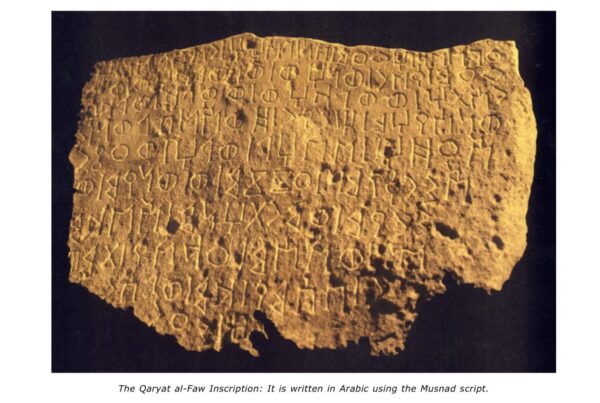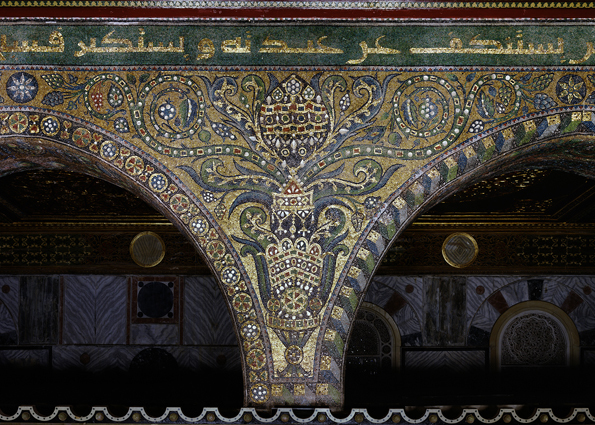Chapter II
Kufi Calligraphy
On Historical Origins of Arabic Script and Historical Development of Kufi Calligraphy
When I first decided to write about my philosophy of history and my Kufi calligraphy and Kufic scripture in general, I thought this was a new opportunity to convey all my ideas more clearly within the illuminating light of Kufic script. So, in the preceding chapter, I have already spoken enough about the problematic aspects of human knowledge and outlined my ideas and evaluations as a prologue to the meaning of kufi calligraphy. Now it is time to tell the story of kufi calligraphy.
Naturally, I’ve already read many well-written books on the paleography and epigraphy of Arabic script by famous Orientalists. Of course, I’ve also read many books, even some manuscripts, by Arab, Persian, or Turkish writers. However, I don’t believe it’s necessary to repeat all the knowledge I’ve learned from those books—all the known and unknown and problematic aspects of the subject. Instead, I’ll offer my interpretations whenever it seems proper to me. Nevertheless, this essay will include a large bibliography for the more interested reader who wishes to learn more.
Let us recall some historical knowledge about the Arab people and the Qur’an: According to the Muslim religion, the Qur’an is the word of Allah revealed by the archangel Gabriel to the Prophet Muhammad. According to the traditional geneology prophet Muhammed`s ancestors descended from Abraham`sson ishmael. And Arab people also are divided into two groups: Adnani (northern Arabs considered Arab i-musta`ribe—that is, “Arabized Arabs” descended from Ishmael)—and Qahtani (southern Arabs, like the Yemenis).This is why the Arabs are called ‘The sons of Ishmael’ by the Jews. According to the Old Testamen, Abraham and Hagar’s son Ishmael had ten children. The names of Ishmael’s first and second sons given by the Old Testament seemed interestingly historical to me referring Nabatian and Kedar kingdoms. Nebaioth, the firstborn of Ishmael, and Kedar. `Now this is the genealogy of Ishmael, Abraham’s son, whom Hagar the Egyptian, Sarah’s maidservant, bore to Abraham. 13 And these were the names of the sons of Ishmael, by their names, according to their generations: The firstborn of Ishmael, Nebajoth; then Kedar, Adbeel, Mibsam, 14 Mishma, Dumah, Massa, 15 [a]Hadar, Tema, Jetur, Naphish, and Kedemah. 16 These were the sons of Ishmael and these were their names, by their towns and their [b]settlements, twelve princes according to their nations.` *1. Kedar is the Father of the Qedarites, a northern Arab tribe that controlled the area between the Persian Gulf and the Sinai Peninsula. According to tradition, he is the ancestor of the Quraysh tribe, and thus, ancestor of the Islamic prophet Muhammad.*2 According to Old Testament Nebaioth was the Father of Nabataean people and according to paleographic and epigraphic investigations by Orientalists, the most widely held guess among them is that Arabic script originated from the Nabataean script.
Indeed, the history of Kufi script again clearly exemplifies the dubious nature of historical knowledge. The origin of Arabic script can not be proven or definitely known at all. There are many different predictions of Orientalists about origins of Arabic script based on various relics and inscriptions.
I think the aforementioned short remarks about my own epistemological reasoning are sufficient to demonstrate my standpoint regarding the dubious nature of historical, theological, mystical, semantic, and artistic aspects of human knowledge in general. Again, I am adding some of my articles about my philosophy of history as annexes, so that, I can express my ideas about history in a larger context than this context which is primarily about kufi calligraphy. Though Bacos says `writing makes an exact man`*3. , I think every word is incomplete as it is said in Ecclesiastes II-8: “All things are hard: man cannot explain them by word. The eye is not filled with seeing, neither is the ear filled with hearing.” *4
For instance, the origins of the Arabic script have been a subject of scholarly debate for centuries. There are two main theories about its origins: the Nabataean Theory and the Musnad Theory.
For example, Irvin Cemil Schick states: `The old and generally dominant view is that Arabic script was derived from Nabataean script; however, the chronological gap between the Nabataean and Arab civilizations necessitates a reexamination of this view. In more recent times, an alternative theory has been proposed suggesting that Arabic script originated from Aramaic/Syriac script. The former view has found support in Anglo-Saxon academic circles, while the latter has been favored in French scholarly environments. It would be highly appropriate for these theories to be discussed in Turkey as well. Yet, this issue—pertaining to the pre-Ottoman Turkish era—has remained off the agenda to this day, like many other “foreign” topics. Only legendary accounts, rather than historical evidence, have appeared in Turkish sources—stories passed down from generation to generation claiming that writing was invented by Prophet Adam or Prophet Idris, and that the first calligrapher was Imam Ali. ` *5
The most widely accepted theory is that the Arabic alphabet evolved from the Nabataean script, which itself was derived from the Aramaic alphabet. This evolution followed this path:
Phoenician alphabet → Aramaic alphabet → Nabataean Aramaic → Nabataean Arabic → Paleo-Arabic → Classical Arabic → Modern Standard Arabic
| Phoenician | Aramaic | Nabataean | Arabic | Syriac | Latin | |
| Image | Text | |||||
| 𐤀 | 𐡀 | ﺍ | ܐ | A | ||
| 𐤁 | 𐡁 | ٮ | ܒ | B | ||
| 𐤂 | 𐡂 | حـ | ܓ | C | ||
| 𐤃 | 𐡃 | د | ܕ | D | ||
| 𐤄 | 𐡄 | ه | ܗ | E | ||
| 𐤅 | 𐡅 | ﻭ | ܘ | F | ||
| 𐤆 | 𐡆 | ر | ܙ | Z | ||
| 𐤇 | 𐡇 | ح | ܚ | H | ||
| 𐤈 | 𐡈 | ط | ܛ | — | ||
| 𐤉 | 𐡉 | ى | ܝ | I | ||
| 𐤊 | 𐡊 | كـ | ܟ | K | ||
| 𐤋 | 𐡋 | لـ | ܠ | L | ||
| 𐤌 | 𐡌 | مـ | ܡ | M | ||
| 𐤍 | 𐡍 | ں | ܢ | N | ||
| 𐤎 | 𐡎 | — | ܣ | — | ||
| 𐤏 | 𐡏 | عـ | ܥ | O | ||
| 𐤐 | 𐡐 | ڡـ | ܦ | P | ||
| 𐤑 | 𐡑 | ص | ܨ | — | ||
| 𐤒 | 𐡒 | ٯ | ܩ | Q | ||
| 𐤓 | 𐡓 | ﺭ | ܪ | R | ||
| 𐤔 | 𐡔 | سـ | ܫ | S | ||
| 𐤕 | 𐡕 | ٮ | ܬ | T | ||
* 6 .wikipedia,

*7
The Nabataean script was used by the Nabataean Kingdom, centered in Petra (in modern-day Jordan) from around the 3rd century BCE. The Nabataeans were predominantly Arab Semitic tribes living in the area, controlling trade routes from the eastern Mediterranean shores to Hijaz (Saudi Arabia) and Yemen. A transitional phase between the Nabataean Aramaic script and a subsequent, recognizably Arabic script, is known as Nabataean Arabic. The pre-Islamic phase of the script as it existed in the fifth and sixth centuries CE, once it had become recognizably similar to the script as it came to be known in the Islamic era, is known as Paleo-Arabic.
An alternative Musnad Theory suggests that the Arabic script can be traced back to Ancient North Arabian scripts, which are derived from the ancient South Arabian script (Arabic: khaṭṭ al-musnad).

*8
`This hypothesis has been discussed by Arabic scholars Ibn Jinni and Ibn Khaldun. Some scholars, like Ahmed Sharaf Al-Din, have argued that the relationship between the Arabic alphabet and the Nabataeans is only due to the influence of the later after its emergence (from Ancient South Arabian script). Arabic has a one-to-one correspondence with ancient South Arabian script except for one letter. German historian Max Muller (1823-1900) thought the Phoenician script was adapted from Musnad during the 9th century BCE when the Minaean Kingdom of Yemen controlled areas of the Eastern Mediterranean shores. Syrian scholar Shakīb ´Arslan shares this view. *9
Thus, to explore the history of the Kufic script is not merely to trace the formal evolution of a writing style. It also raises critical questions of historiography and epistemology. The origins of writing, its transformations, the contexts of its use, and the aesthetic choices it entails are shaped not only by material evidence but also by historical assumptions, intellectual frameworks, and interpretive narratives.
That is, historical origins of the Kufic script are not limited to the linear evolution of the Arabic script; they also reflect a broader cultural, political, and theological transformation. The development of Kufic writing corresponds with a rapidly evolving epistemological and aesthetic quest in the wake of Islam’s emergence. As a script, Kufic embodies the early Muslim community’s dual concern: preserving the Qur’anic revelation with precision and imparting to it a form of solemnity and visual dignity.
Because I do not wish to write a large book volume about the paleography of Arabic script, like many Orientalists have done before me, I will only mention here some good sources—which are easily reachable on the internet—about the history of “Arabic people, Arabic inscriptions, Arabic script, and Kufic scripture, etc.” *6.
One can find many examples from the Nabataean script and other Arabic inscriptions discovered by archaeologists on internet sites. There are some websites on the internet that show all the Arabic inscriptions and scripts, including new archaeological discoveries, such as:
- Digital archive for the study of pre-Islamic Arabian inscriptions: https://dasi.cnr.it/
- History of the Arabic alphabet – Wikipedia
- https://corpuscoranicum.de/en
- https://en.wikipedia.org/wiki/Category:Arabic_inscriptions
- https://www.islamic-awareness.org/history/islam/inscriptions
Rather than conveying all the historical information I’ve gathered from the books of Orientalists and Muslim scholars, I wish to interpret certain aspects of Kufic scripture as they relate to various differing perspectives, whenever it seems imperative to do so. This is precisely why I have already articulated my epistemological standpoint concerning the myriad viewpoints across different disciplines. For instance, we possess numerous historical relics of Arabic scripts—inscriptions, papyri, manuscripts written on parchment, and later, coins minted by Umayyads, as well as buildings like the Dome of the Rock, which is ornamented with Kufic calligraphy.
Indeed, the Kufic style, as anyone who has seen it can tell, is perfect for stone inscriptions – its simplistic, angular, and overall lapidary nature make it so.
Kufi calligraphy from The Dome of the Rock, one of the the oldest Islamic buildings, was constructed under the auspices of Umayyad ruler Adb al-Malikin 692. *10… Monuments · The Kufic Script: Form Follows Function · CB 51 Omeka
It seems scholars can never fully agree on these matters: the origin of the Arabic people, Arabic language, Arabic script, and Kufic script all appear dubious because of the many divergent interpretations offered by historians. I think these paleographic and epigraphic studies, with their vast amounts of comparable data, should be analyzed by an artificial intelligence. I will not reiterate all the perplexing details of those paleographic investigations; nevertheless, I will provide a bibliography for curious readers, and many useful websites contain all those specific details.
For now, I recall what Wordsworth once said:
Enough of science and of art
Close up those barren leaves
Come forth and bring with you a hearth
That watches and receives. *11

